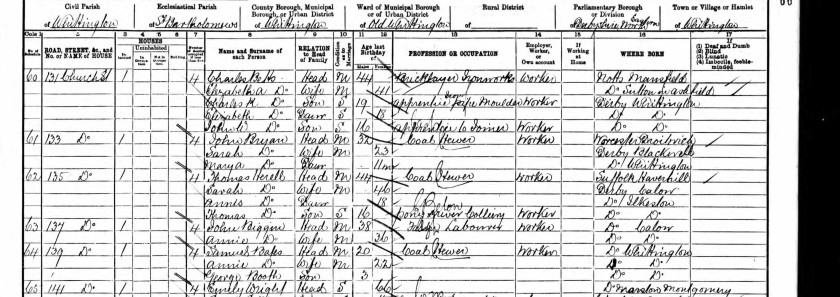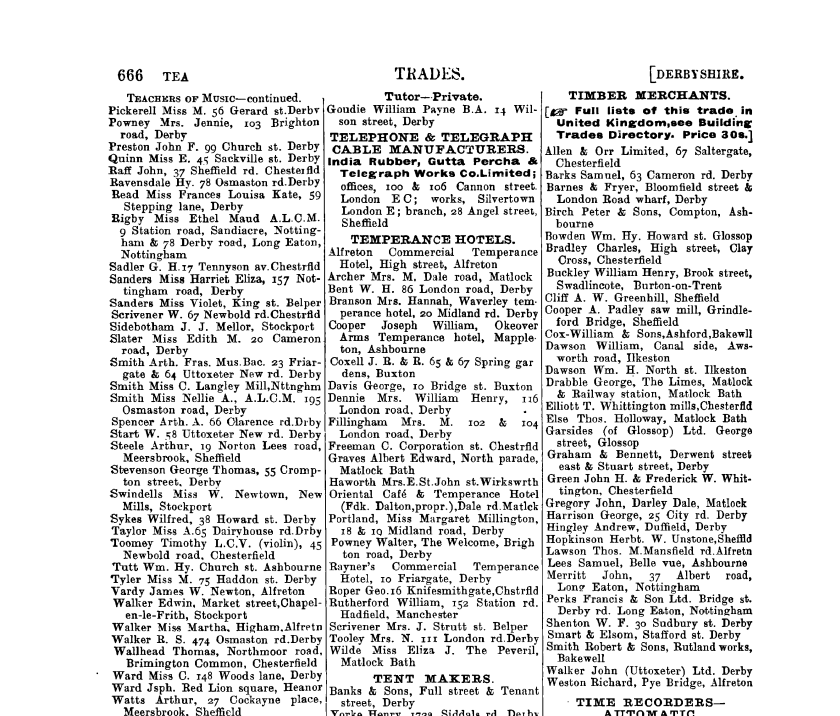George Bates was born in Whittington on 26th August 1897. His mother was Eliza Annie Booth. Eliza married Samuel Bates in 1900 and according to the 1901 census the family were living at 139 Church Street Old Whittington, Samuels occupation was given as a coal hewer.

George started school on 8th January 1902. He attended Websters Endowed School and left on 9th January 1905. His fathers name is given as Samuel and his address in Church Street.

I have to assume that Samuel died between 1908 and 1911 (however at the moment I haven’t found any evidence on-line). At the beginning of 1911 Eliza married Robert Loomes.
The 1911 census shows that Eliza and Samuel had five children and Eliza and Robert had a daughter. They were living at 86 Church Street Old Whittington and Roberts occupation was given as a labourer. George is listed as Robert Loomes stepson, he is 13yrs old and attending school.

After leaving school George went to work for J H & F W Greens Timber Store. According to Kellys 1912 Directory of Derbyshire, Greens Timber Store was in Whittington.
There was a wood yard at the bottom of Whittington Hill, this could possibly have been where George worked.

The timber yard was on the right just beyond the railway line.
George enlisted in the army in Chesterfield on 15 April 1915, and was a Private (service number 18317) in the 9th Battalion Cameronians (Scottish Rifles).
![Cameronians[1]](https://oldwhittingtonopscom.files.wordpress.com/2018/09/cameronians1.gif?w=840) The cap badge of the Cameronians
The cap badge of the Cameronians
Image from https://en.wikipedia.org/wiki
He arrived in France on 3rd October 1915.
Unfortunately his Service records must have been destroyed in 1940 when the war Office repository in London was hit by a German Bomb.
George was killed in action on 3rd July 1916, he was 18 years old.

Picture from Derbyshire Courier 22nd July 1916
Official government policy was that you had to be 18 to sign up and 19 to fight overseas. In the early twentieth century most people didn’t have birth certificates, so it was easy to lie about your age. George was not alone being so young in battle. At the outbreak of war in 1914, the British Army had 700,000 available men. Germany’s wartime army was over 3.7 million. When a campaign for volunteers was launched, thousands answered the call to fight. Among them were 250,000 boys and young men under the age of 19, the legal limit for armed service overseas.
Further information on boy soldiers at
It is probable that George would have been involved in the Battle of the Somme and the 9th Battalion were recorded as taking part in the Battle of Albert on 1st July 1916 and the Battle for Bernefay Wood on 3rd July 1916.
During the first day of the Battle of the Somme the 9th Cameronians remained in reserve as part of 27th Brigade, 9th Division, and on 3 July moved up to the front line at Montauban. When the Cameronians relieved the 2nd Battalion, Wiltshire Regiment, heavy German shelling depleted their initial strength of 20 officers and 659 men. The work of consolidating their front line trenches was made difficult by heavy rain and very dangerous by artillery fire. The Battalion’s war diary in The National Archives records that between 3 and 8 July, when the Cameronians were relieved, their casualties amounted to 32 dead, 5 died of wounds, 100 wounded, and 2 missing believed killed.
The above account was taken from National Records for Scotland and the full account can be seen here
A newspaper entry for George in the Derbyshire Courier 22nd July 1916 reads:
Private George Bates, Scottish Rifles, was killed on 2nd July in the ‘big push’. Prior to his enlistment on 15 April 1915 he lived at old Whittington and worked at Messrs J H and F W Greens timber store. He had been in France nine months. A friend of his writing from the battle front says that Private Bates was killed in the advance but he cannot at present give any particulars. He advises the recipient to break the news to Private Bates mother.
This information contradicts George’s date of death on the grave registration, but I imagine it was very difficult to be accurate in the heat of battle.
George is buried at Quarry Cemetery Montauban a link to the Cemetery information can be found here
![quarry-cem-montauban-16[1]](https://oldwhittingtonopscom.files.wordpress.com/2018/09/quarry-cem-montauban-161.jpg?w=840)
Picture https://www.ww1cemeteries.com/
According to the grave registration details George was buried originally where he fell and removed to Montauban at a later time.


George was awarded the British War and Victory Medals along with the 14/15 Star.

George is remembered on Old Whittington and the Brushes War Memorials and the 9th Cameronians Roll of Honour at
George’s mother continued to live in Old Whittington with her husband Robert Loomes and in 1939 they were listed as living at Newbridge Street.
Robert Loomes also served in WW1 and in 1916 he was injured. Quite by co-incidence the article in the Derbyshire Courier 22 July 1916, informing of George’s death also informed that Robert Loomes had been injured. The two photos were posted side by side! It must have been a very heart-breaking time for Mrs Loomes.

ADDENDUM:
After I finished my research I was contacted by a family member who advised that George Bates mother and George Barker’s step-mother were sisters (Eliza Annie Booth and Mary Ann Booth) the two boys were not just good friends they were also step cousins and portrays how the First World War affected families in small communities.

